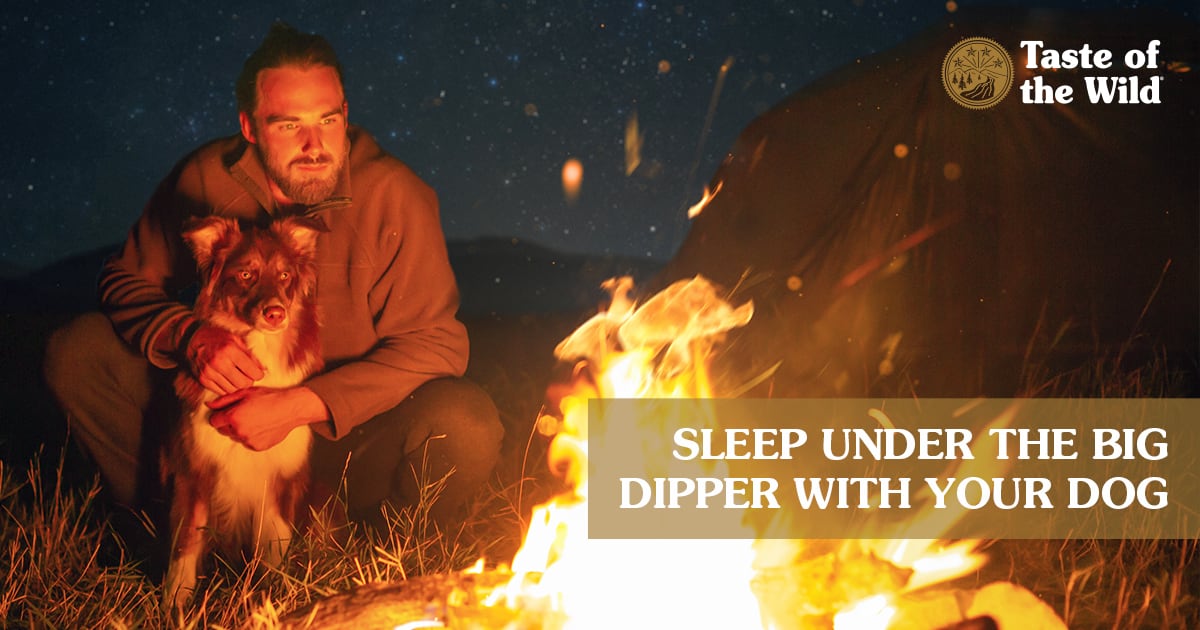
What could be better than stretching out in the moonlight, lulled to sleep by the rustling of leaves, a chorus of crickets and the gentle snoring of your canine companion? Camping with your dog can be truly memorable. Here are a few tips to get you started safely.
Talk to your veterinarian. With any luck, your dog will make friends on your camping trip, so you want to make sure he or she is current on vaccines. Now’s a good time to stock up on flea, tick and heartworm preventives, too.
Be easy to find if your dog gets lost. Even the best-behaved dogs can get distracted (squirrel!) and take off running. Before you go, make sure your dog’s ID tags contain all your current contact information. Consider a temporary tag with your campground and campsite number, or the number for the nearest ranger station. If your dog has a microchip, call the manufacturer to make sure the chip is registered with the current contact information. You might also want a dog collar with a GPS feature.
Pack all your pooch supplies. Think of everything your dog needs during a 24-hour period, including food (pack enough for a few extra days), bowls, medications, bedding, a leash, toys, a crate, a yard stake with a short cable, poop bags, towel, brushes and a first aid kit that includes fine-tipped tweezers for removing ticks.
Find dog-friendly campsites: Most national and state park websites will tell you if dogs are welcome, but you can also try searching the web for pet-friendly campsites. Helpful websites include Bring Fido and GoPetFriendly.
Know trail regulations. Just because the campsite is dog friendly doesn’t mean the hiking trails are. Most U.S. national parks don’t allow dogs on trails, even if they’re leashed. If you plan on hiking with your dog, make sure to check the rules before you go.
Drill your dog on obedience skills. To be respectful of your camping neighbors, refresh your dog’s memory on commands such as “come,” “stay,” “drop it” and “quiet.”
Plan for your dog’s drinking water. If the campsite doesn’t offer drinking water, don’t rely on lakes, rivers or streams for your dog to lap from. Some natural bodies of water may contain toxins such as blue algae or harmful germs like Giardia. If using water from natural sources, bring a water purifying kit.
Make your dog comfortable. While you’re setting up the campsite, stake your dog on a short cable or let them relax in the comfort of their crate, so your hands are free. Place a tarp under your tent to protect your dog from the cold, damp ground and bring foam padding and a comforter for bedding. If your dog has a short, thin, coat, consider bringing a doggy sweater for when the temperatures drop at night.
Keep food locked away. You shouldn’t tempt bears and other wildlife with your food, so remember to protect your dog’s food as you would your own. Keep it in a sealed, waterproof container and hoist it high off the ground, if necessary.
Be a good campsite neighbor. Most campsites require your dog to be leashed at all times, so keep your dog from wandering to meet the neighbors. Don’t go on hikes and leave your dog behind on a cable, in a crate or in the car. You don’t want your dog to become a barking nuisance, run after wildlife or be caught in sudden weather changes.
Know the location of the closest emergency veterinary clinic. If your dog has a close encounter of the wildlife kind, such as a tangle with a rattlesnake or porcupine, you will need to seek veterinary help fast.
With a little planning, you can create great memories camping with your dog.
The information in this blog has been developed with our veterinarian and is designed to help educate pet parents. If you have questions or concerns about your pet's health or nutrition, please talk with your veterinarian.
